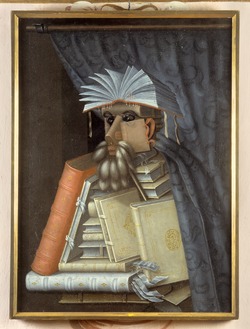The Librarian (Arcimboldo)
| The Librarian | |
|---|---|
 | |
| Artist | Giuseppe Arcimboldo |
| Year | circa 1566 |
| Type | Oil on canvas |
| Dimensions | 97 cm × 71 cm (38 in × 28 in) |
| Location | Skokloster Castle |
| Accession | 11616 |
The Librarian is an oil on canvas painting by Giuseppe Arcimboldo in the collection of Skokloster Castle in Sweden. It is thought to be a portrait of Wolfgang Lazius, a humanist and historian who served Holy Roman Emperors of the House of Habsburg.[1]
Arcimboldo became official portraitist to Emperor Maximilian II in 1562.[2] The Librarian is one of a series of paintings by Arcimboldo of members of Maximilian's entourage.[3] Skokloster Castle dates the painting to 1562,[3] though the painting is more often dated circa 1566.[1][2][4][5]
Arcimboldo created a number of portraits of people by painting an assemblage of objects such as fruits and vegetables, flowers, or in this case, books; the objects typically had some connection to the person's life or depiction. Benno Geiger called it a "triumph of abstract art in the 16th century".[4] In 1957, art historian Sven Alfons was the first to conclude that this was specifically a portrait of Lazius.[1][5] The work has been interpreted as both a celebration and a satirical mocking of librarians and scholarship. K. C. Elhard suggests that it may be specifically a parody of "materialistic book collectors more interested in acquiring books than in reading them."[1]
Elhard notes that The Librarian has become "a fixture in the visual history of the library profession".[1] However, the original title, if any, is unknown, and its current title first appears (in Swedish as "Bibliotekarien") in an early 20th-century inventory.[1]
The Librarian is one of two works by Arcimbolodo in the collection of Skokloster Castle. The painting was brought to Sweden following the looting of Prague Castle by the Swedish army during the 1648 Battle of Prague and was owned by General Hans Christoff von Königsmarck.[3]
There are three other extant versions of the painting whose attributions are uncertain.[1] A scientific study published in 2011 concluded that The Librarian was a later copy of Arcimbolodo's original painting, whose whereabouts are unknown.[6]
References
- ^ a b c d e f g Elhard, K.C. (Spring 2005). "Reopening the Book on Arcimboldo's "Librarian"". Libraries & Culture. 40 (2): 115–127. doi:10.1353/lac.2005.0027.
- ^ a b Greggs, Jeffrey (December 2010). "Arcimboldo 1527–1593: Nature & Fantasy". The New Criterion. pp. 49–50.
- ^ a b c "Livrustkammaren och skoklosters slott med stiftelsen hallwylska museet: En myndighet tre museer". Retrieved 3 September 2013.
- ^ a b Werner Kriegeskorte (2000). Arcimboldo. Ediz. Inglese. Taschen. p. 30. ISBN 978-3-8228-5993-3.
- ^ a b Thomas DaCosta Kaufmann (2009). Arcimboldo: Visual Jokes, Natural History, and Still-Life Painting. University of Chicago Press. p. 259. ISBN 978-0-226-42686-0.
- ^ Frantisek Makes; Maria Brunskog (2011). Enzymatic Restoration and Authentication of Giuseppe Arcimboldo's "Vertumnus". Gotland University. ISBN 978-91-86343-08-8.
